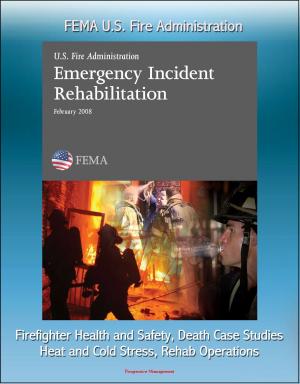21st Century U.S. Military Documents: Civil Engineer Guide to Expeditionary Force Protection (Air Force Handbook 10-222, Volume 3) - Barriers, Bollards, Barricades
Nonfiction, History, Military, Aviation| Author: | Progressive Management | ISBN: | 9781301066780 |
| Publisher: | Progressive Management | Publication: | October 11, 2013 |
| Imprint: | Smashwords Edition | Language: | English |
| Author: | Progressive Management |
| ISBN: | 9781301066780 |
| Publisher: | Progressive Management |
| Publication: | October 11, 2013 |
| Imprint: | Smashwords Edition |
| Language: | English |
This handbook supports force protection training outlined in AFI 10-210, Prime Base Engineer Emergency Force (BEEF) Program. It describes expeditionary force protection tactics, techniques, and procedures (TTPs) Air Force (AF) civil engineers can use to protect critical assets including personnel, facilities and equipment during deployments. It is applicable to active duty, Air National Guard, and Air Force Reserve engineers.
Force Protection (FP) is an overarching concept that should not be used synonymously with Antiterrorism (AT). AT is a sub-element of combating terrorism, which is a subset of the broader FP concept. FP is inherent to command and must be a commander's top priority at all times. This handbook provides guidance on implementing FP measures in the expeditionary environment. Many of the references listed throughout this handbook are For Official Use Only (FOUO) publications. Planners should gain access to these publications and download them to secure media to ensure they are available throughout all phases of deployments.
Force Protection Defined. Joint Publication (JP) 1-02, Department of Defense Dictionary of Military and Associated Terms, defines FP as "actions taken to prevent or mitigate hostile actions against Department of Defense (DOD) personnel and their families, resources, facilities, and critical information." This protection is necessary to ensure the force is fit and capable of applying decisive and overwhelming force at the right place and time to achieve US objectives. Concern for the health and welfare of the force must always be paramount. FP efforts must be geared towards coordinated and synchronized offensive and defensive measures which enable effective employment of forces while simultaneously degrading opportunities for the enemy. The DOD definition excludes actions to defeat the enemy or protect against accidents, weather, or disease as elements of force protection. Air Force Doctrine Document (AFDD) 2-4.1, Force Protection, states that the AF views FP as an integrated application of offensive and defensive actions to deter, detect, preempt, mitigate, or negate threats against USAF air and space operations and assets based on an acceptable level of risk. Key to the AF view of FP is the protection of its people. It is important to note that the AF considers prevention of accidents, along with protection against various forms of disease, especially those induced through hostile action, to also be elements of FP.
Chapter 1 * INTRODUCTION * 1.1. Overview * 1.2. Force Protection Defined * 1.3. Elements of Force Protection * 1.4. Operations Security (OPSEC) * 1.5. Force Protection Condition (FPCON) System * 1.6. Terrorist Threat Levels * 1.7. Training * Chapter 2 * COMBATING TERRORISM * 2.1. Overview * 2.2. Antiterrorism * 2.3. Counterterrorism * 2.4. Threat Assessment * 2.5. Criticality Assessment * 2.6. Vulnerability Assessment * 2.7. Risk Management * 2.8. Random Antiterrorism Measures (RAMs) * Chapter 3 * FORCE PROTECTION PLANNING * 3.1. Overview * 3.2. Force Protection Plan * 3.3. Resource Constraints * 3.4. Site Selection * 3.5. Site Layout * 3.6. Unified Facilities Criteria * Chapter 4 * PHYSICAL SECURITY * 4.1. Overview * 4.2. Aspects of Physical Security * 4.3. Perimeter Security * 4.4. Internal Security * Chapter 5 * INTEGRATED BASE DEFENSE (IBD) * 5.1. Overview * 5.2. Essential Capabilities of IBD * Attachment 1 * GLOSSARY OF REFERENCES AND SUPPORTING INFORMATION * Attachment 2 * BASELINE FPCON * Attachment 3 * SITE SELECTION AND LAYOUT CONSIDERATIONS
This handbook supports force protection training outlined in AFI 10-210, Prime Base Engineer Emergency Force (BEEF) Program. It describes expeditionary force protection tactics, techniques, and procedures (TTPs) Air Force (AF) civil engineers can use to protect critical assets including personnel, facilities and equipment during deployments. It is applicable to active duty, Air National Guard, and Air Force Reserve engineers.
Force Protection (FP) is an overarching concept that should not be used synonymously with Antiterrorism (AT). AT is a sub-element of combating terrorism, which is a subset of the broader FP concept. FP is inherent to command and must be a commander's top priority at all times. This handbook provides guidance on implementing FP measures in the expeditionary environment. Many of the references listed throughout this handbook are For Official Use Only (FOUO) publications. Planners should gain access to these publications and download them to secure media to ensure they are available throughout all phases of deployments.
Force Protection Defined. Joint Publication (JP) 1-02, Department of Defense Dictionary of Military and Associated Terms, defines FP as "actions taken to prevent or mitigate hostile actions against Department of Defense (DOD) personnel and their families, resources, facilities, and critical information." This protection is necessary to ensure the force is fit and capable of applying decisive and overwhelming force at the right place and time to achieve US objectives. Concern for the health and welfare of the force must always be paramount. FP efforts must be geared towards coordinated and synchronized offensive and defensive measures which enable effective employment of forces while simultaneously degrading opportunities for the enemy. The DOD definition excludes actions to defeat the enemy or protect against accidents, weather, or disease as elements of force protection. Air Force Doctrine Document (AFDD) 2-4.1, Force Protection, states that the AF views FP as an integrated application of offensive and defensive actions to deter, detect, preempt, mitigate, or negate threats against USAF air and space operations and assets based on an acceptable level of risk. Key to the AF view of FP is the protection of its people. It is important to note that the AF considers prevention of accidents, along with protection against various forms of disease, especially those induced through hostile action, to also be elements of FP.
Chapter 1 * INTRODUCTION * 1.1. Overview * 1.2. Force Protection Defined * 1.3. Elements of Force Protection * 1.4. Operations Security (OPSEC) * 1.5. Force Protection Condition (FPCON) System * 1.6. Terrorist Threat Levels * 1.7. Training * Chapter 2 * COMBATING TERRORISM * 2.1. Overview * 2.2. Antiterrorism * 2.3. Counterterrorism * 2.4. Threat Assessment * 2.5. Criticality Assessment * 2.6. Vulnerability Assessment * 2.7. Risk Management * 2.8. Random Antiterrorism Measures (RAMs) * Chapter 3 * FORCE PROTECTION PLANNING * 3.1. Overview * 3.2. Force Protection Plan * 3.3. Resource Constraints * 3.4. Site Selection * 3.5. Site Layout * 3.6. Unified Facilities Criteria * Chapter 4 * PHYSICAL SECURITY * 4.1. Overview * 4.2. Aspects of Physical Security * 4.3. Perimeter Security * 4.4. Internal Security * Chapter 5 * INTEGRATED BASE DEFENSE (IBD) * 5.1. Overview * 5.2. Essential Capabilities of IBD * Attachment 1 * GLOSSARY OF REFERENCES AND SUPPORTING INFORMATION * Attachment 2 * BASELINE FPCON * Attachment 3 * SITE SELECTION AND LAYOUT CONSIDERATIONS















